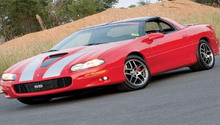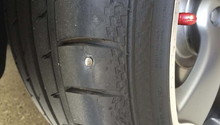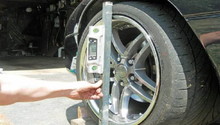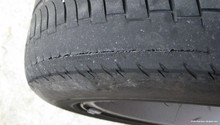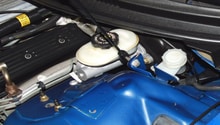Camaro and Firebird: Tire Diagnostics Guide
If you’ve never dealt with issues like uneven tire wear, pull, slow leaks, wandering, then consider yourself lucky. The tires on your Camaro or Firebird are the most used, and most exposed components of your vehicle, and they’re the most susceptible to damage. Plus, they wear out just in everyday use, and can go bad just from sitting.
This article applies to the Camaro and Firebird (1993-2015).
Tires going bad can present themselves in a lot of different ways, and the symptoms can easily be mistaken for any number of more expensive problems. Bad tires with tread separation can sound like a bad wheel bearing or stuck caliper. Worn tires can cause the car to wander on the road and follow imperfections, much like a bad tie rod end or ball joint does. Even just over or under-inflated tires can cause your car to drive strangely, and handling as well as mileage can suffer. If you suspect an issue may be tire related, there is a simple way to test it; rotate your tires. If the noise moves with the tire, or the problem seems to go away, chances are it was one or more of the tires.


Materials Needed
- Car jack (to elevate the car as needed)
- Tire iron
- Tire gauge
- New wheels and rims (as necessary)
- Spray bottle with soap and water
Step 1 – Uneven wear
Inspect the tires. If you see a bald spot, feathering, or any other odd looking pattern of wear, it’s an indication that the alignment of your vehicle is out of spec. Cupping of the tire, meanwhile, can indicate bad shocks, poor balance, or a worn ball joint. Here are a couple of other things to look for:
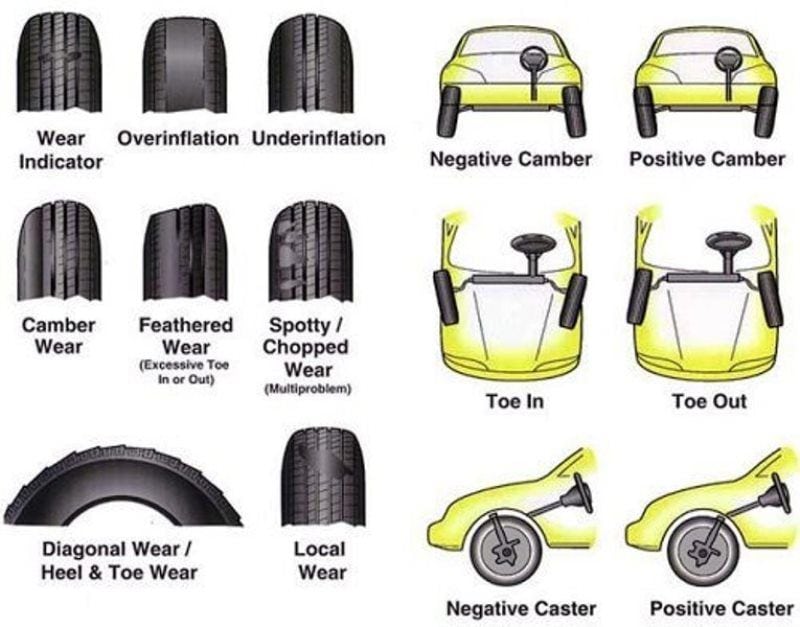
Study the center of the tire and its edges—if there’s more wear here, signs are the tires was driven for a time with improper inflation; specifically, both edges indicate under-inflation, while wear in the center indicates over-inflation (adjust as needed). If you see discoloration on the sidewall, or cracking for that matter, it indicates dry rot from under-inflation and the tire will need to be replaced.
If there’s edge wearing at the far ends of the tires (near the sidewall), this indicates camber wear; specifically, if the inside edge is worn down, there’s too much negative camber. Outside wear indicates too much positive camber, which will also lead to poor front end grip.
Should you find even wear, with the most at one edge and tapering to the center of the tires, it might also be a toe issue—too much toe out indicates inside wear, while too much toe in indicates outside wear. A bad tie rod with lots of play in it can cause the toe in/out to vary constantly depending on a turn of the wheel, and lead to play in the steering and even wear.
Step 2 – Pulling to one side
Most of the time, if your car is pulling to one side rather than the other, it’s more a problem with the brakes; that is, one side is getting more stopping power than the other. Check for wear on the brake pads to see if one wheel is wearing faster than the other. You can also jack up the car and make sure all of the wheels turn freely, and don't turn when a helper presses the brake.

If the brakes look good, you may want to switch the front tires from side to side and take the car for a spin. If the tire itself is bad, the car should pull to the other side now. Typically, a tire that pulls is suffering from tread separation and needs to be replaced. Tread separation can also make a rumbling noise as it rolls.
Another issue could be the shocks. Push down on each corner of the car, the car should bounce back up, then settle. If the car bounces repeatedly, or doesn't bounce at all, the shocks may be blown. Or, you could have too stiff a spring if the car has been modified.
If all else fails, the alignment in your car could be off—this often happens if the vehicle strikes something stationary like a curb and slightly bends a tie rod end or control arm. A sloppy ball joint, or worn out rubber bushings can cause a similar issue. Jack the car up and pull the wheel to check for play in any and all directions where there shouldn't be any. You may need to take the car in and have it professionally checked and aligned.
Step 3 – Leaking
There are a couple of reasons why your tire might be leaking air. If you are trying to discover the source of the leak, a spray bottle with any sort of soap. When you find a suspect spot, spray it and look for bubbles made by the escaping air.
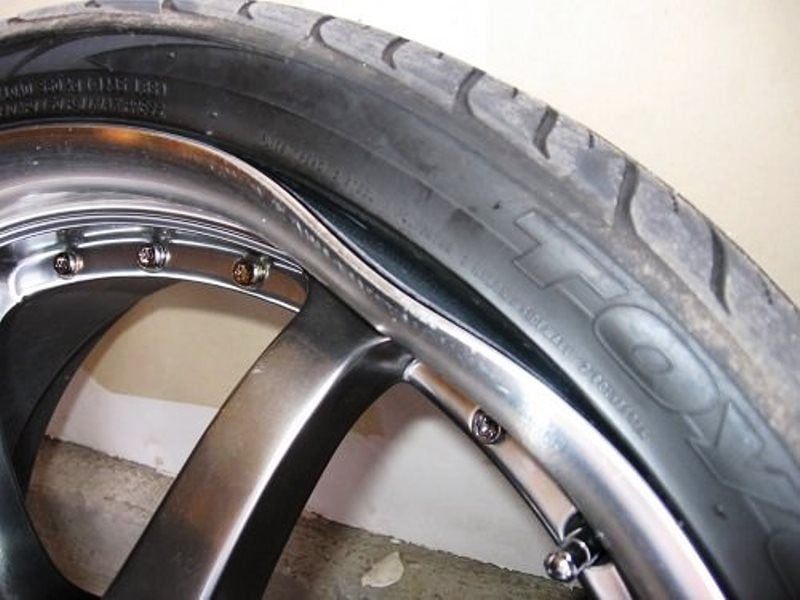
If you’re recently had the tires mounted to the rims, there’s a chance they weren’t seated properly. You can try airing it down, spraying soap on the edge of the tire and rim, and over-inflating it. This will sometimes allow the tire to seat on the rim and be airtight, just be sure to let the air out down to the proper inflation level. It is also possible that the tire valve itself is not properly seated, or is leaking from the valve. Use the bubble method to check.
There’s also the chance the tire struck a stationary object like a curb, or pothole, which caused the wheel rim to bend or crack. If that’s the case, you’ll likely need to get the rim itself replaced (rim repair jobs often cost close to as much as a rim replacement).
If the rims are steel, there’s also the chance some rust developed in the bead area—this prevents a good seal between the tire and rim. The solution here would be to demount the tires, remove the rust, prime the area, and paint with a good rust protective paint. Rust on steel rims has even been known to get so bad as to allow air to leak right through it, but typically only in areas with lots of winter road salt.
Still no issue found? Try taking the wheel off and test for leaks by submerging the whole thing in a tub of water. If there are bubbles, mark the spot. You may be able to plug the tire once you know where the leak is.
Related Discussions
- Tire Wear Tell - LS1Tech.com
- Outer Edge Tire Wear Why? - LS1Tech.com
- Tire Leaks Air Between Rim Tire - LS1Tech.com
- Car Pulls Right While Driving Braking — What the Hell? - LS1Tech.com
- Could Bad Rim Cause Pull Right? - LS1Tech.com

